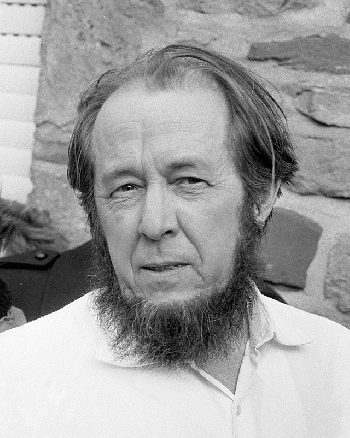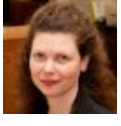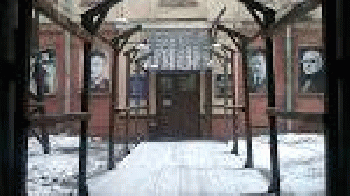I met my guide Natalia outside of the apartment at 10:00 am to begin our all-day tour of Moscow. We went around the corner to the bus stop across the street from the American Embassy. The bus took us close to our first destination of the day: the Gulag Museum.
The Gulag Museum is a large red rectangular building with numerous windows covered with closed wooden shutters. This is the first unsettling clue of what awaits inside.
The Museum, which was moved to this area from its former location closer to central Moscow a couple of years ago, is now open to individual visitors for self-guided tours, whereas before only group tours were accommodated. Natalia explained to me that this new iteration of the Museum was more elaborate, having been designed by professionals for a more realist atmosphere and the addition of more artifacts from the actual prison camps.
The atmosphere, including dim lighting and dirge-like music in some areas, was certainly evocative and creepy. In the first room was a large four-sided frame with about 8 to 10 actual doors from Gulag cells affixed to three of the four sides. Each door included a card, in both Russian and English, stating which camp the door was from. The worn and pock-marked doors were made of wood, metal, or a combination of both. Most had a small square window that opened out in the middle, presumably for the passing of food. All had sliding bars and heavy locks. The fourth side of the frame was open and I could see the interior of the doors - the side the prisoners saw for hours, months or years - that is, when they weren't toiling in the extreme cold.
Standing in that dark entryway and gazing into the enclosed space with those doors, I was overcome with a sudden wave of nausea and had to sit down for a minute before continuing on with the exhibit. I had requested to visit this museum for educational reasons but wondered how much of this I'd be able to get through before wanting to bolt. Ultimately, I was able to push myself on for about an hour.
Various artifacts from the Gulag prisons could be seen hanging on the walls of this same room, such as a prisoner's shirt, a small lantern from a cell, metal beds and benches, and a pair of handcuffs.
On one wall was a schematic illustration of one of the gulag prison camps before it was constructed.
In the next room were several glass cases. One displayed fragments of letters written by the prisoners on cloth, typically parts of clothing, as they were provided no paper. Another displayed pieces of wood with messages written on them by the prisoners, demonstrating their need to communicate with anyone who might see it. One case had items that had been made by some female prisoners, such as a utility box and shoes, constructed from whatever materials they could get their hands on.
In another room was a long table with photos and biographies of prisoners who survived the camps and wrote about it. A copy of some of the books written appeared in front of the author's picture. Of course, the most recognizable was Aleksandr Solzhenitsyn.

Aleksandr Solzhenitsyn 1974crop
(Image by (From Wikimedia) Verhoeff, Bert / Anefo, Author: Verhoeff, Bert / Anefo) Details Source DMCA
The second to last room I was in had 3 video screen displays on one wall. The middle screen had a continually scrolling list in white against a black background of the names of those who'd been executed directly during the Great Purge of 1936-38. This would have been 700,000 to 750,000 people out of the 1.5 million that were arrested during that period.
The screen on the left had photos and a brief description of certain prisoners along with the dates of their arrest and execution. These people were engineers, teachers, military officers and other average people - all of whom had been declared "enemies of the people." I stopped to study the faces of a few of these individuals - one man in particular stood out to me because of his sad eyes. I wondered if the photos were taken at the time of arrest (did he know his fate?) or if they were just everyday photos that may have been available.
The screen on the right had portions of actual lists of those to be arrested and executed projected on to it.
The last room I was in had a large television with video interviews playing of several elderly people who'd survived the prisons, discussing their ordeals, particularly their feelings about what life was like after they were released, including the process of becoming "rehabilitated." After Stalin's death in 1953, Nikita Khrushchev denounced Stalin and gradually released all of the prisoners, shutting down the Gulags and implementing a program of re-integration. Khrushchev later admitted that he'd had much blood on his hands from the Stalin era, but that he and many others knew that if they resisted they would have also been executed without a second thought.
I remembered one of the explanatory panels in the exhibit stated that Stalin's goal was to "destroy the possibility of political opposition, to nip non-conformity in the bud."
Natalia and I sat on the bench in front of the television talking about the video when a young man from Kazakhstan briefly joined in our discussion. Upon realizing that I was American he politely asked me some things about the United States, including Guantanamo prison. I answered his questions as best I could. He also mentioned that there were people in Kazakhstan - a part of the Soviet Union at the time - who lived in the old buildings there that had constituted some of the Gulag prisons. When Natalia and I expressed surprise at this, he simply replied that the buildings were sturdy so people put them to use.
(Note: You can view every article as one long page if you sign up as an Advocate Member, or higher).






